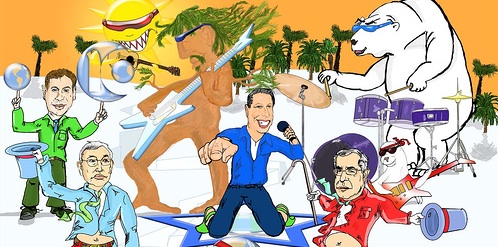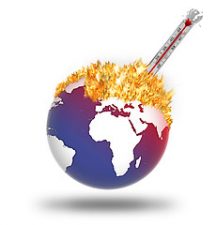The Earth has a memory. It has records of African flowers blooming in the summer; it remembers cold, desolate Arctic winters since winters began, and the spawning of coral in the Great Barrier Reef one night, every spring.
I remember my first lesson as a child, on how the Earth remembers. The teacher had brought in a slice of wood from an old pine tree. Based on the number, thickness and colour of the rings we could tell how old the tree was when it was felled, if the tree was well watered, and if the summer of any given year was warm or cold.
Later, I learned, it is not only trees that Mother Nature imbues with memories. The Earth keeps mementos locked in time in most any place we look.
On the coast of Israel we can find traces of an anienct tsunami; in Canada we can see how the glaciers thousands of years ago dragged snow and rock across Ontario; in Mexico, we can see where a giant asteroid – the Chicxulub – pounded into the sea – an event that is believed to have caused a nuclear winter.
In recent years, along with the explosive population of humans, the Earth has started to record different memories. Pollen records from lakes, the chemical composition of corals, and the oxygen bubbles trapped in the glaciers reveal startling facts: that the amount of carbon released in the atmosphere every year is climbing steadily.
Carbon is the building block of life. Plants exchange carbon dioxide that our mammalian bodies exhale. Carbon also builds our bones, and it is the same material that makes trees strong.
Today, as more and more people inhabit the planet, the natural balance of carbon locked into the earth, and that which is released, has changed.
The result is Global Warming. We can no longer ignore that our planet is heating up. And unless we change the way we travel, heat our homes and consume our food, humanity, within the next couple of decades, could meet a very uncertain future.
“The world must embrace a carbon-neutral lifestyle,” says Al Gore, who produced a film about global warming, An Inconvenient Truth. “To do otherwise,” he says, “will result in a cataclysmic catastrophe.”
In this movie, Al Gore, presents the facts. We are currently emitting 70 million tons of global warming into the atmosphere every day, which means that we have doubled the amount of carbon dioxide in the atmosphere only in the last fifty years. If the frozen carbon dioxide in Siberia should melt (and with temperatures rising this is not so inconceivable – most of Greenland is melting) we will double the amount again, and ridiculous amounts of methane will be in the atmosphere.
Erin McKean, editor in chief of the New Oxford American Dictionary explained why the word carbon neutral was word of the year for 2006:
“The increasing use of the word carbon neutral reflects not just the greening of our culture, but the greening of our language. When you see first graders trying to make their classrooms carbon neutral, you know the word has become mainstream.”
The two greatest sources of carbon dioxide gases in the world comes from slash and burning of forests for cattle which produce methane gas; and fossil fuels that drive our cars and heat our homes.
With 6.5 billion people on the planet and counting, the future doesn’t look good.
How can we measure our individual impact and decrease our carbon footprint?
Action at the community and government level is clearly not working fast enough. Large corporations and politicians are thinking about profits, returns and gains on investment before thinking about responsible, non-polluting business practices.
It is easier for us to do something about Global Warming if we can understand what our own carbon footprint on the earth is. If public opinion and action changed the size of a growing ozone hole, we can certainly do the same for Global Warming.
To measure your carbon footprint, several organizations have developed a carbon calculator. With it, you can see how much carbon you and your family are adding. The goal is to become carbon neutral – where your carbon load is stabilized and offset by other carbon sequestering means such as through the planting of trees.
Adopting vegetarianism, use of public transportation and your bike, as well as purchasing local products that don’t involve long distance shipping can help; as well as the use of a clothesline to dry your clothes.
And since it is the shorter journeys before your engine is warm that produces the greatest amount of pollutants – jump on your bike for a quick trip to the store instead of using the car.
If you are going to idle for more than 2 minutes, turn your engine off and also make sure your tires are inflated. Avoid accelerating or braking quickly and park in the shade as sun on a hot car also produces smog. If you really want to make a big difference, drive a hybrid car.
Also signing up to invest in alternative and renewable energy such as solar and wind energy will counteract some of our negative habits. The sun, like a huge lightbulb, is only eight minutes away, and what is stopping us from having a solar powered planet?
Planting trees is also an important step forward, as they take in the carbon dioxide that pollutes our planet. At present the world’s forests are too quickly being destroyed.
Forest Fires are on the increase with lightning meeting rising climate temperatures and people are too readily using trees for living purposes. Last year in the USA, 57 million trees were used to make catalogues (that then pollute the street where you are living..)and it is estimated that 30 million dollars can be saved every year on greenhouse pollution by using recycled paper.
We can’t forget that the Earth has a memory. We have to wake up collectively and take responsibility for our actions if we want to minimize our carbon footprints on the Earth.
That way, the Earth and our future generations will be able to experience African flowers blooming in the summer; the cold, desolate Arctic winters since winters began, and the spawning of coral in the Great Barrier Reef one night, every spring.





